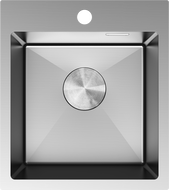
When buying a new sink or kitchen sink for your home, you cannot forget about the essential element for its proper functioning, which is the trap. It will also be useful when connecting a bathtub, shower, or bidet to the sewage network. It is crucial to choose a trap suitable for each of the mentioned devices. If you are wondering about the types of traps, we most often deal with traditional models, which are manual, and with automatic traps. Don't know what differentiates these two solutions? No worries, we will explain it right away.
Explore the Types of Traps Available on the Market
The trap plays a crucial role in the water and sewage installation, which is responsible for quickly and effortlessly disposing of water from the sink, basin, or bathtub. It is an indispensable element of every kitchen sink; without it, not only would there be no way to drain water, but also nothing would block unpleasant smells from the sewage from entering the house. All traps available on the market serve the same purpose, differing in appearance or operational principle. The mechanism of the plug can also vary. Generally, we can distinguish:
-
manually closed trap,
-
automatic trap,
-
p-trap,
-
bottle trap.
When buying a trap, you should check the drain diameter in advance to ensure it fits your existing sink or washbasin. Connecting the trap is incredibly simple and can be done independently without the need to call in professionals or acquire specialized tools.
Automatic vs Traditional Trap – Key Features
The distinction between automatic and manual traps really comes down to how the plug functions. An automatic plug located in the drain at the bottom of the sink does not require wetting your hands to unblock it. It is equipped with a lever usually mounted near the faucet, and opening and closing the drain valve is done using a knob.
A standard trap, or manual one, is equipped with a plug whose insertion and removal are done manually. While closing the water outlet does not require wetting your hands, when emptying the sink, you need to submerge your hand in water to open the drain. Regardless of which trap you have in your kitchen, it is essential to remember to have an anti-overflow system connected to the sink. This will help avoid flooding the room if too much water is accidentally poured into the sink.

Automatic Plug or Traditional Plug?
Both automatic and manual traps have their supporters and opponents. If you don’t like putting your hand into the sink basin and searching for the plug in dirty water, the automatic plug will definitely be a better choice. Opening and closing the sieve occurs by pulling the lever or turning the knob.
Taking into account the aesthetic aspect, the choice of a trap depends on personal preferences. An automatic trap looks more modern and elegant than a manual plug. However, the traditional plug can also be stylish, especially if you choose a click-clack model. It is convenient to use since closing and opening the drain occurs with a light press on the plug, requiring no pulling or sucking.
Choose the Right Trap for Your Home
When choosing a trap for a granite sink or any other, it is also worth matching it to the style of the sink. Various colored plugs are available on the market to choose from. A manual trap is most often equipped with a rubber plug ending with a handle, making it easy to remove. On the other hand, automatic plugs and click-clack models are often made of brass or steel, thus presenting themselves much better.
It is hard to definitively indicate which type of trap is better, as both have their proponents. Rubber and metal plugs are relatively easy to keep clean, effectively block water drainage, and prevent unpleasant odors from the sewage from entering the house.


















